
+- WildFact (https://wildfact.com/forum)
+-- Forum: Information Section (https://wildfact.com/forum/forum-information-section)
+--- Forum: Terrestrial Wild Animals (https://wildfact.com/forum/forum-terrestrial-wild-animals)
+---- Forum: Carnivorous and Omnivores Animals, Excluding Felids (https://wildfact.com/forum/forum-carnivorous-and-omnivores-animals-excluding-felids)
+----- Forum: Canids (Canidae) & Hyaenids (Hyaenidae) (https://wildfact.com/forum/forum-canids-canidae-hyaenids-hyaenidae)
+----- Thread: Pleistocene wolf discovered in Yakutia (/topic-pleistocene-wolf-discovered-in-yakutia)
Pleistocene wolf discovered in Yakutia - Pckts - 06-10-2019
Still snarling after 40,000 years, a giant Pleistocene wolf discovered in Yakutia
By The Siberian Times reporter
07 June 2019
Sensational find of head of the beast with its brain intact, preserved since prehistoric times in permafrost.
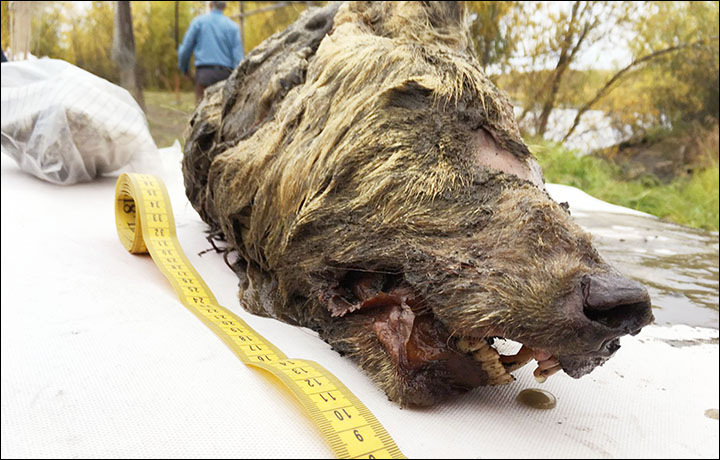
*This image is copyright of its original author
The Pleistocene wolf’s head is 40cm long, so half of the whole body length of a modern wolf which varies from 66 to 86cm. Picture: Albert Protopopov
The severed head of the world’s first full-sized Pleistocene wolf was unearthed in the Abyisky district in the north of Yakutia.
Local man Pavel Efimov found it in summer 2018 on shore of the Tirekhtyakh River, tributary of Indigirka.
The wolf, whose rich mammoth-like fur and impressive fangs are still intact, was fully grown and aged from two to four years old when it died.
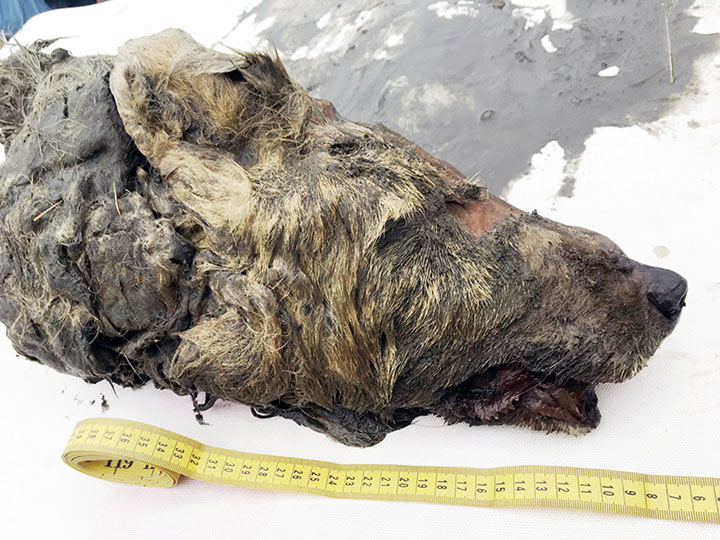
*This image is copyright of its original author
The wolf, whose rich mammoth-like fur and impressive fangs are still intact, was fully grown and aged from two to four years old when it died. Picture: Albert Protopopov
The head was dated older than 40,000 years by Japanese scientists.
Scientists at the Swedish Museum of Natural History will examine the Pleistocene predator’s DNA.
‘This is a unique discovery of the first ever remains of a fully grown Pleistocene wolf with its tissue preserved. We will be comparing it to modern-day wolves to understand how the species has evolved and to reconstruct its appearance,’ said an excited Albert Protopopov, from the Republic of Sakha Academy of Sciences.
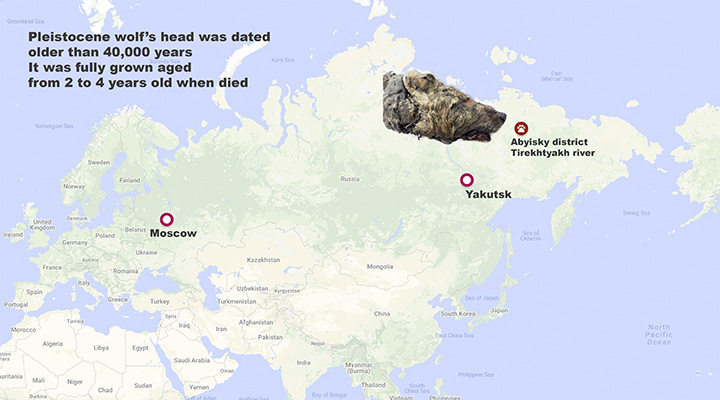
*This image is copyright of its original author
Local man Pavel Efimov found it in summer 2018 on shore of the Tirekhtyakh River, tributary of Indigirka.
The Pleistocene wolf’s head is 40cm long, so half of the whole body length of a modern wolf which varies from 66 to 86cm.
The astonishing discovery was announced in Tokyo, Japan, during the opening of a grandiose Woolly Mammoth exhibition organised by Yakutian and Japanese scientists.
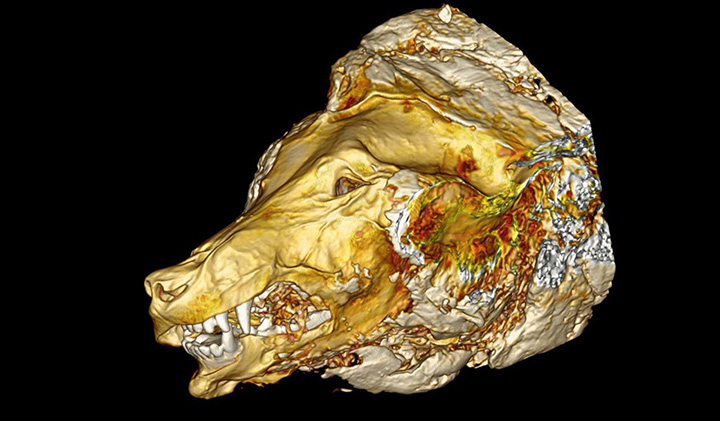
*This image is copyright of its original author
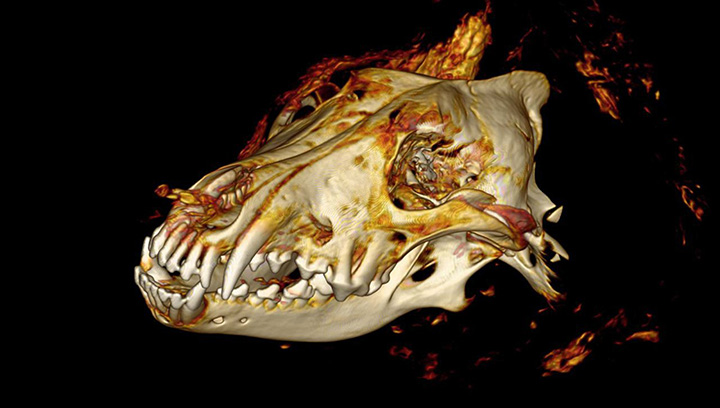
*This image is copyright of its original author
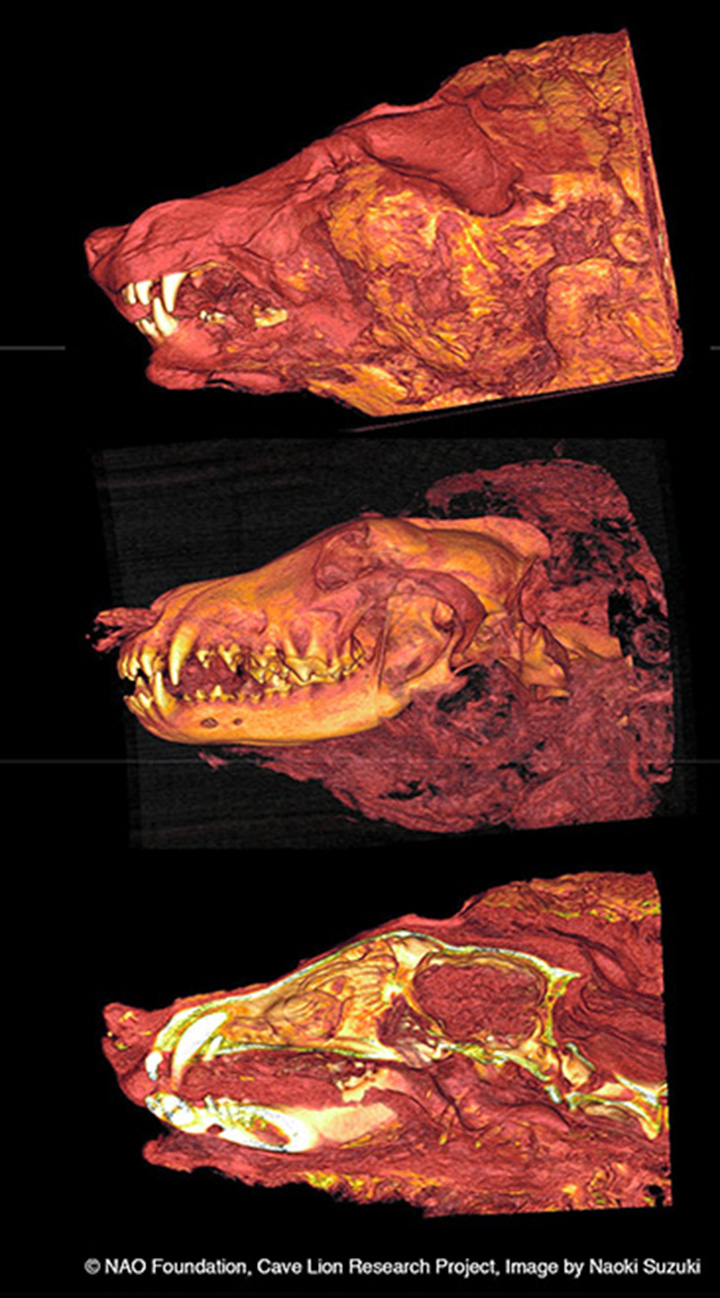
*This image is copyright of its original author
CT scan of the wolf's head. Pictures: Albert Protopopov, Naoki Suzuki
Alongside the wolf the scientists presented an immaculately-well preserved cave lion cub.
‘Their muscles, organs and brains are in good condition,’ said Naoki Suzuki, a professor of palaeontology and medicine with the Jikei University School of Medicine in Tokyo, who studied the remains with a CT scanner.
‘We want to assess their physical capabilities and ecology by comparing them with the lions and wolves of today.’
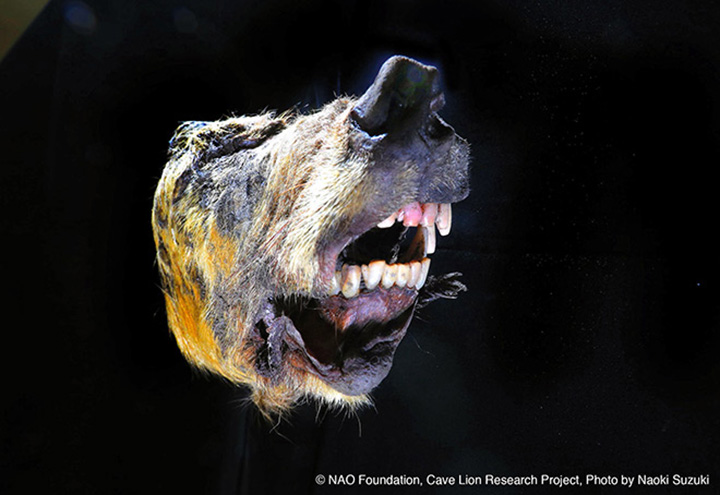
*This image is copyright of its original author
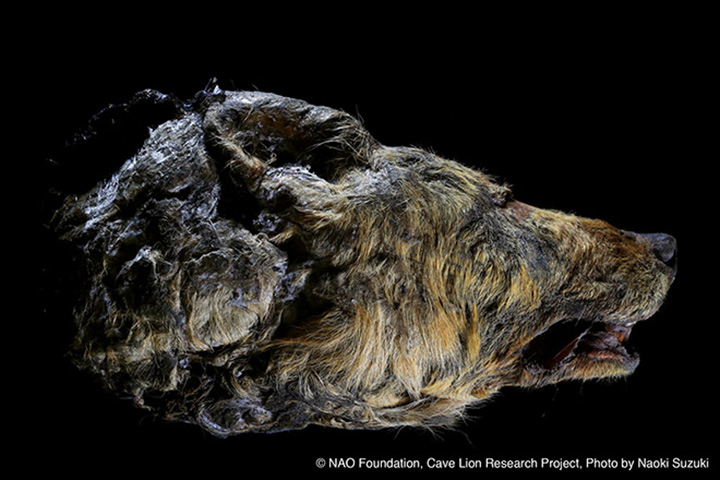
*This image is copyright of its original author
‘This is a unique discovery of the first ever remains of a fully grown Pleistocene wolf with its tissue preserved.' Pictures: Naoki Suzuki
The cave lion cub named Spartak - previously announced - is about 40cm long and weighed about 800 grams.
Scientists believe the cub died shortly after birth.
The recent discovery follows that of the remains of three cave lions in 2015 and 2017 by the same team.
The cave lion cub named Spartak - previously announced - is about 40cm long and weighed about 800 grams. Pictures: The Siberian Times, YSIA
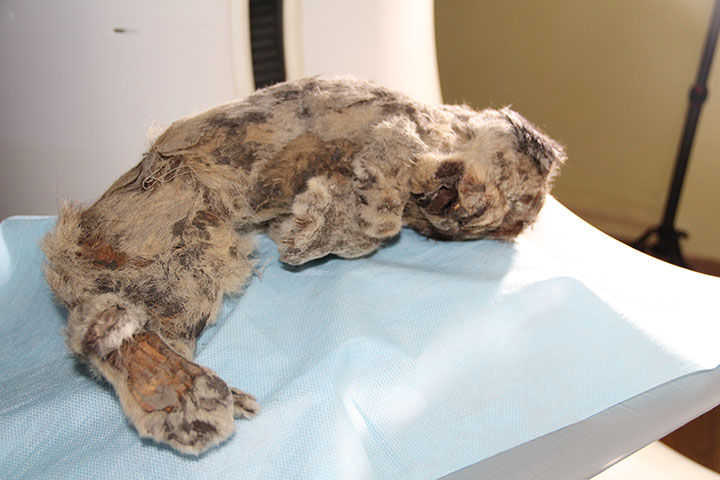
*This image is copyright of its original author
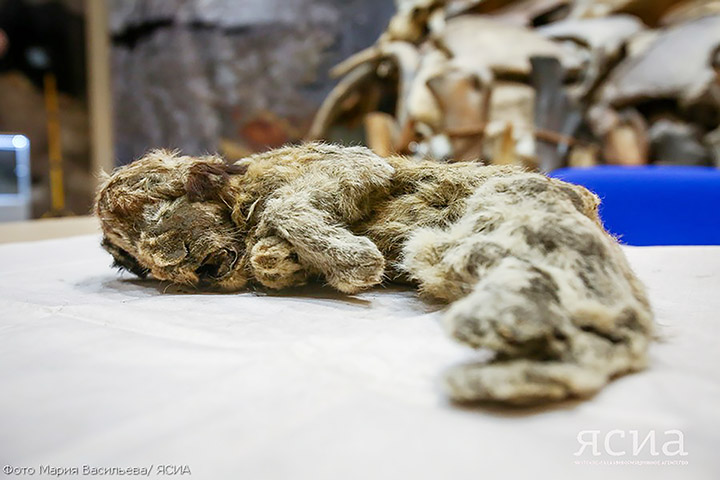
*This image is copyright of its original author
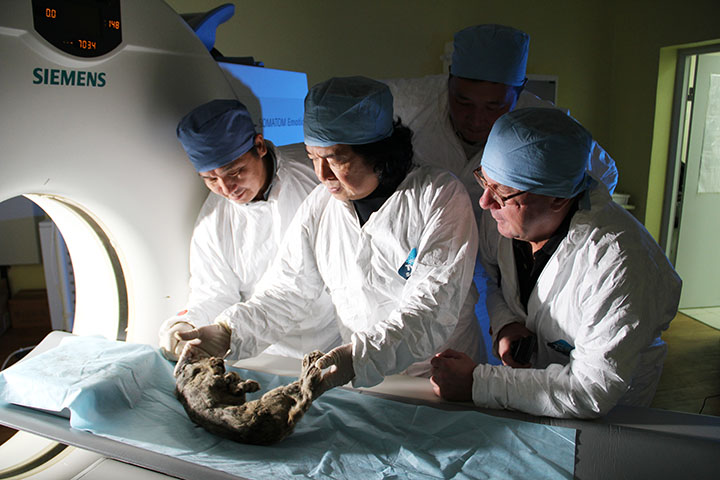
*This image is copyright of its original author
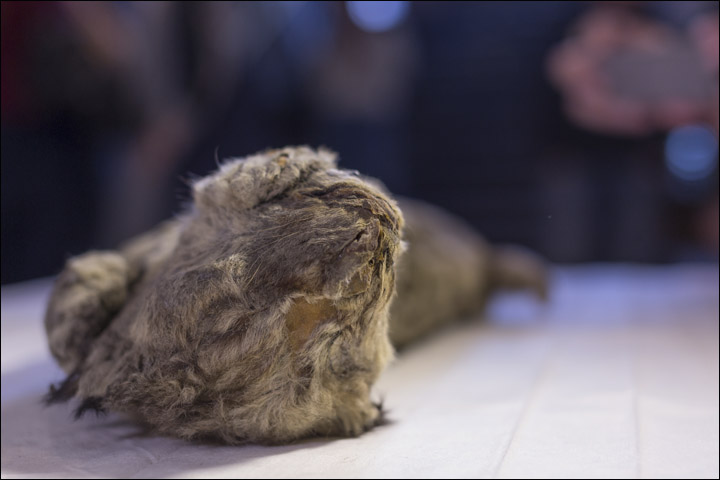
*This image is copyright of its original author
RE: Pleistocene wolf discovered in Yakutia - Sully - 06-13-2019
Truly amazing find. Will be looking forward to the forthcoming analysis. Surely one of the best ever preserved finds from any prehistoric age.
RE: Pleistocene wolf discovered in Yakutia - peter - 06-13-2019
(06-13-2019, 01:46 AM)Sully Wrote: Truly amazing find. Will be looking forward to the forthcoming analysis. Surely one of the best ever preserved finds from any prehistoric age.
Yes, a unique find it was. The photographs really opened the door to a lost world.
It's not the first time this newspaper ('The Siberian Times') published interesting information about the natural world in the Russian Far East.
Good find, PC.
RE: Pleistocene wolf discovered in Yakutia - Shadow - 06-13-2019
(06-10-2019, 11:17 PM)Pckts Wrote: Still snarling after 40,000 years, a giant Pleistocene wolf discovered in Yakutia
By The Siberian Times reporter
07 June 2019
Sensational find of head of the beast with its brain intact, preserved since prehistoric times in permafrost.
*This image is copyright of its original author
The Pleistocene wolf’s head is 40cm long, so half of the whole body length of a modern wolf which varies from 66 to 86cm. Picture: Albert Protopopov
The severed head of the world’s first full-sized Pleistocene wolf was unearthed in the Abyisky district in the north of Yakutia.
Local man Pavel Efimov found it in summer 2018 on shore of the Tirekhtyakh River, tributary of Indigirka.
The wolf, whose rich mammoth-like fur and impressive fangs are still intact, was fully grown and aged from two to four years old when it died.
*This image is copyright of its original author
The wolf, whose rich mammoth-like fur and impressive fangs are still intact, was fully grown and aged from two to four years old when it died. Picture: Albert Protopopov
The head was dated older than 40,000 years by Japanese scientists.
Scientists at the Swedish Museum of Natural History will examine the Pleistocene predator’s DNA.
‘This is a unique discovery of the first ever remains of a fully grown Pleistocene wolf with its tissue preserved. We will be comparing it to modern-day wolves to understand how the species has evolved and to reconstruct its appearance,’ said an excited Albert Protopopov, from the Republic of Sakha Academy of Sciences.
*This image is copyright of its original author
Local man Pavel Efimov found it in summer 2018 on shore of the Tirekhtyakh River, tributary of Indigirka.
The Pleistocene wolf’s head is 40cm long, so half of the whole body length of a modern wolf which varies from 66 to 86cm.
The astonishing discovery was announced in Tokyo, Japan, during the opening of a grandiose Woolly Mammoth exhibition organised by Yakutian and Japanese scientists.
*This image is copyright of its original author
*This image is copyright of its original author
*This image is copyright of its original author
CT scan of the wolf's head. Pictures: Albert Protopopov, Naoki Suzuki
Alongside the wolf the scientists presented an immaculately-well preserved cave lion cub.
‘Their muscles, organs and brains are in good condition,’ said Naoki Suzuki, a professor of palaeontology and medicine with the Jikei University School of Medicine in Tokyo, who studied the remains with a CT scanner.
‘We want to assess their physical capabilities and ecology by comparing them with the lions and wolves of today.’
*This image is copyright of its original author
*This image is copyright of its original author
‘This is a unique discovery of the first ever remains of a fully grown Pleistocene wolf with its tissue preserved.' Pictures: Naoki Suzuki
The cave lion cub named Spartak - previously announced - is about 40cm long and weighed about 800 grams.
Scientists believe the cub died shortly after birth.
The recent discovery follows that of the remains of three cave lions in 2015 and 2017 by the same team.
The cave lion cub named Spartak - previously announced - is about 40cm long and weighed about 800 grams. Pictures: The Siberian Times, YSIA
*This image is copyright of its original author
*This image is copyright of its original author
*This image is copyright of its original author
*This image is copyright of its original author
Nice find, when I read article quickly, one sentence was odd and there is clearly false information. Here quote:
"The Pleistoccene wolf´s head is 40 cm long, so half of the whole body length of a modern wolf which varies from 66 to 86 cm. Picture: Albert Protopopov"
That what is told as body length is shoulder height of the modern wolf and some can be even more that that. When talking about body length, that would be medium-sized or smallish dog, not even close, what wolf is. I quickly measured my dog. When ruling out tail and neck+head, it is 70 cm. So that is only body/torso, no tail or neck+head included. And my dog isn´t even closely as big as grey wolf is.
Body length of modern grey wolf is something like 100-140 cm without tail. Some big individuals might be more, but now I don´t have time to check so good.